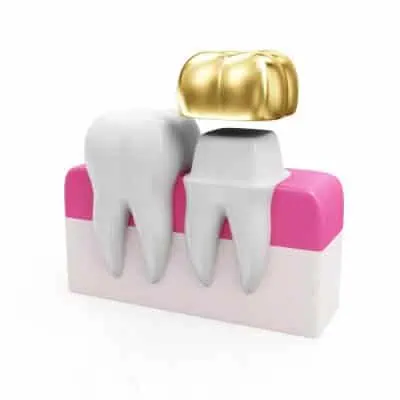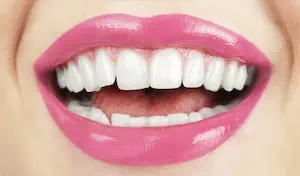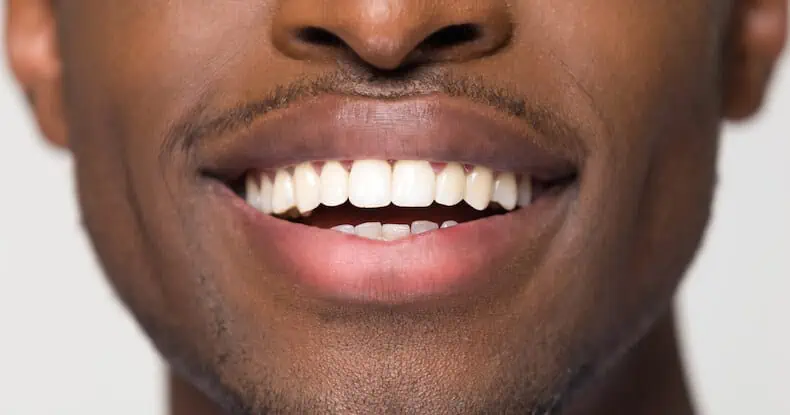Temporary teeth can temporarily fill in the space of a missing or damaged tooth while you wait for a more permanent restorative dentistry solution. Whether you have a missing tooth from gum disease, trauma or decay, it's important to get the problem fixed as soon as possible, but sometimes it's just not realistic to get it done right away. That's why, in the article, we will go over your options for temporary teeth, why you might need them and how to care for them.
In This Article
Temporary tooth replacement
A temporary tooth is used to fill in space for a missing tooth or to temporarily cover the abutment of a dental implant while the bone heals around the implant. Your dentist may recommend that you wear a temporary tooth to protect the space left by your missing tooth and stop other teeth from shifting into that space. The material used for temporary teeth is usually acrylic-based or stainless steel, this ensures that you can eat with the tooth still in your mouth. The different options for temporary teeth include:
- Crowns
- Dentures
- Retainers
- Clip-on
- DIY
Temporary implant crown

Cemented temporary crowns are by far the best option for covering dental implants. When your dentist recommends an implant as your replacement teeth option, the process of healing the bone around the implant will take some time. Instead of putting in the permanent tooth replacement, the option for a temporary crown will most likely be the way to go.
While you wait for your permanent option to be made in the lab, this acrylic tooth-shaped piece will be cemented on the abutment of your dental implants to ensure that your remaining teeth don't shift out of place and that the implant site isn't damaged due to exposure during the healing process. The acrylic material is more likely to match the color of your smile than the metal option, but both are only temporary.
Temporary false teeth
Another option, especially if multiple teeth are in need of replacement, is a temporary removable partial denture. These are made from acrylic material, and a false tooth is set into each space needed. They are secured in your mouth with metal clasps that attach to the adjacent teeth. These are sometimes more noticeable than metal partial dentures but are also easier to adjust and often more affordable. Same-day dentures are also an option, and give you a full smile until your regular dentures are ready.
A dental flipper is essentially the same thing as a partial denture. This method is used as a temporary tooth replacement while the patient waits for their permanent denture set or dental implant. These are a good option if your dentist says that you need to have the space filled during the time that you are waiting for a more permanent solution.
Retainer with fake teeth
If you are not a candidate for dental implants then another option for a temporary tooth is a retainer with multiple or a single fake tooth set into it. A clear Essix retainer for missing teeth is a removable option. Retainers with fake tooth inserts are molded to fit over your smile and have acrylic pieces set into the missing tooth spaces. This method can prevent shifting and is a more personalized temporary tooth replacement as you will need an exact mold of your smile so the acrylic retainer will fit seamlessly. This same method can be used with a Hawley retainer or even braces with fake teeth attached. This option isn't an immediate solution as it takes time for the mold to be made in the lab and then sent back to your dentist to be fit for you.
Clip-on tooth

Temporary front tooth replacement can be as easy as clipping on veneers to the face of your damaged chompers. These are a type of temporary cosmetic teeth that need to be removed when sleeping and eating as they are not cemented on like a permanent veneer. This is not restorative dentistry, and offers none of the health benefits of dental implants, but it's also a much cheaper option.
DIY temporary tooth
Amazing Temporary Tooth is a company that sells kits to make your own removable temporary teeth. Basically, you make a mold for the open space in your smile and follow the instructions in the kit. It's held in place using a wedging effect. This option is one of the fastest available and it will only take as long as it takes you to make your new tooth. Plus, it doesn't require a trip to the dentist. This is also only meant to be a very temporary option until you can get a real replacement.
How to care for a fake tooth
Each option has it's own care instructions. Some options can be left in while you eat, such as crowns and flippers, while others need to be removed, like Temptooth, clip-on, and retainers.

Crowns will require cleaning much like a regular tooth but with extra care to ensure that no particles are left around the gum. Your dentist can recommend a good strategy for ensuring that your temporary crown doesn't cause health problems while you await your permanent one.
Flippers, Temptooth, clip-on veneers, and retainers will need to be handled in similar manners. They can be removed at night to soak in a denture cleaning solution and brushed with a soft-bristle toothbrush as would be done with any other dental device. It is important to remember to remove the dental device at night to prevent it from becoming dislodged and accidentally swallowed, and to prevent it from causing further damage to your mouth.
Pros and cons of temporary teeth
There are several pros and cons to temporary tooth solutions:
Pros
- Quickly fills the gap for cosmetic reasons.
- Prevents shifting and the need for alignment dentistry later on.
- Cheaper than permanent options.
Cons
- Not permanent, will need to be replaced repeatedly until permanent options is fixed.
- Higher risk of decay due to the amount of cleaning needed to maintain optimal health.
- Uncomfortable, especially with dentures and retainers.
Conclusion
One thing nobody wants is a gap in their smile before or during dental treatment. Some temporary teeth can help prevent your smile from shifting or looking incomplete. Dental flippers, retainers, clip-ons, crowns, and DIY pieces are all available in a variety of affordable options. Ensuring that proper care is taken of each device will extend the lifespan beyond the minimum and give you more time to work with your health care provider on more permanent options such as dental implants.
FAQ
How long do temporary teeth last?
Depending on the type of device you choose, the lifespan can range from 2-3 weeks to several years. A temporary crown is only meant to be a placeholder for a few weeks. A retainer or dental flipper set can last several years.
How much is a temporary tooth?
Depending on the type of device you choose, the price can vary from some pocket money to several hundred dollars. The cheapest options are DIY temporary tooth sets. You can buy them online or at the pharmacy at around $20, and the most expensive option is either a crown or a set of clip-on veneers which will set you back around $500+.
What is a temporary tooth?
Temporary teeth are acrylic or metal fake teeth used to fill in gaps in your smile or to cover the abutment of an implant site while it heals. Temporary teeth are not meant to be permanent.
Can I eat with a temporary tooth?
It depends on the type of temporary tooth you have. Some options will allow you to eat with them still set in place, but it is inadvisable to eat hard or sticky foods.
Mayo Clinic: Dental implant Surgery. Consulted 22, June 2020.
American Dental Association: Crowns. Consulted 22, June 2020.




